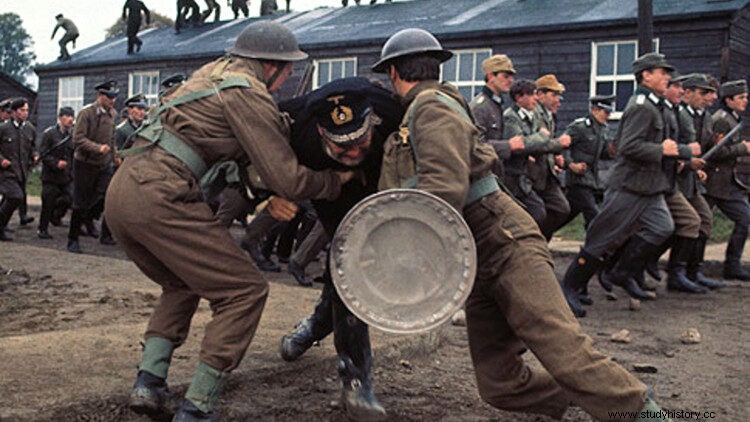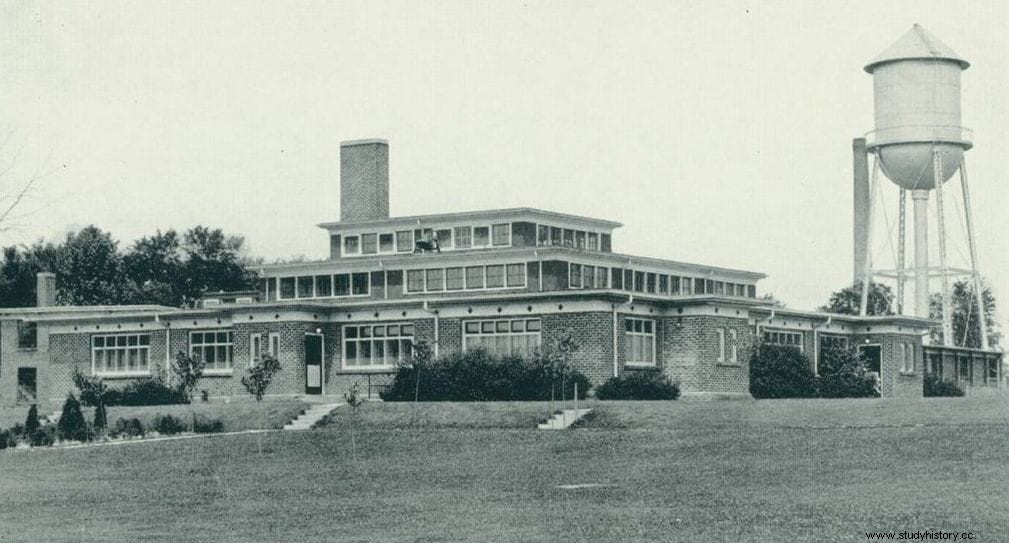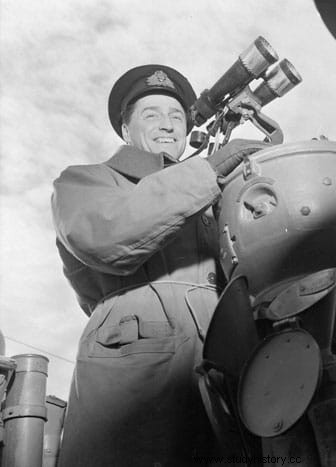Although war cinema has been at ease with films about the escapes of Allied soldiers from German concentration camps during World War II, it has not done so much the other way around, that is, narrating those of German prisoners. There are some because there were real attempts and there were at least seven on a large scale, such as Papago Camp (Arizona) or Bridgen (Wales). Since those fields used to be outside mainland Europe, the involvement of submarines was often necessary and a good example was the audacious Operation Kiebitz , to which another equally daring attempt was made to oppose.
The scenario took place on the other side of the Atlantic, in the Canadian town of Bowmanville (Ontario), where the Bowmanville POW Camp, also known as Camp 30, had been built for German prisoners of war. It was originally a farm ceded by its owner to the government in 1922 for the re-education of juvenile delinquents and, under the name of Bowmanville Boys Training School, it functioned for that purpose until 1941, when the course of the war had already produced a good number of captured enemies that needed to be located somewhere, the boys were sent home and their place was taken by the Teutons.
There were barely seven months to recondition the field because the facilities were not ready for that new function. There were few barracks available and many more had to be built, not counting the security elements:from nine watchtowers to lodgings for the guards, passing through a perimeter of wire fences four and a half meters high. The work ended at the end of that year, just when the first inmates began to arrive -mostly sailors, but also members of the Luftwaffe and the Afrika Corps- and the flow continued to grow until in 1942 there were already so many that any spark could cause a riot, as it actually happened.

It happened in October, when several of the thousands of prisoners rebelled against the threat of putting some of them in chains in retaliation for an escalation in that sense in Germany. Camp commander James Taylor asked Georg Friemel, a senior German officer, to supply a hundred of his men or ask for volunteers to wear shackles for a while, but he got a resounding no for an answer. Taylor then ordered to do it by force and several prisoners barricaded themselves in the dining room led by Horst Elfe, Otto Kretschmer and Hans Hefele. Armed with stakes, iron bars, and whatever they could find, they faced off against a hundred or so Canadian soldiers who had come specifically to cut them down and equipped with baseball bats.
Camp 30 became the scene of a monumental stick fight that ended with a good number of men dislocated. That bizarre duel lasted five days but in the end the Canadians prevailed thanks to the use of pressurized water hoses. And although firearms had been avoided so as not to cause a massacre, a German named Volkmar König was wounded by a bullet and another by a bayonet, although ironically the one who took the worst part was a Canadian with a skull fracture after receiving the impact from a jam jar. One hundred twenty-six prisoners, who had been particularly distinguished by their aggressiveness, were distributed to other camps and calm returned to that corner of Ontario.

Or so it seemed. Of course, escape attempts were frequent despite the fact that in Camp 30 the inmates received treatment similar to that of local citizens and had a similar if not higher standard of living, as happened in many other places such as the American Fritz Ritz. Camp 30 had a swimming pool and sports fields, the inmates received their pay and could buy multiple products, they formed an orchestra and a theater group, the food was excellent... But frequently the desire for freedom used to prevail among the most restless. Already on November 25, 1941, shortly after the prisoners arrived, one tried to sneak past under the barbed wire, being quickly reduced. On December 30, another tried his luck hiding in a laundry truck, but he too was discovered. And during a routine inspection in July 1943, a map and various tools were seized from a third party.
They were individual attempts doomed to failure because, in any case, they had very little chance of returning to their country while in Canada. More important were the planned escapes on a larger scale, based on drilling tunnels. There were several, the most promising being the one they named Haus IV :it was half a meter wide for a similar height, being supported by wooden supports every one or two meters and having both a lighting system -hacked from the power lines- and another ventilation system, made by hand with tin cans. Unfortunately for its future users, in September 1943 the weight broke it down and the guards later blinded it.

However, the most ambitious escape plan was the one carried out under the name of Operation Kiebitz , which was not conceived by the prisoners but by the Kriegsmarine, with the aim of rescuing officers from submarines; were needed because, at this point in the war, the fleet of U-boats it had become Germany's main asset in the war at sea, its surface ships unable to compete with the overwhelming combination of the Royal Navy and the US Navy. And among those chosen was a quartet that included the leaders of the aforementioned mutiny plus other aces of submarine warfare:Otto Kretschmer, captain of U-99; Horst Elfe, captain of U-93; Hans Ey, captain of U-433; and Hans Joachim Knebel-Döberitz, Admiral Dönitz's former aide.
The plan, which if successful would also provide good publicity, was designed in 1942 but with a view to implementation in September 1943. Basically it was to escape from Bowmanville and travel a thousand and a half kilometers north to New Brunswick. There, in Chaleur Bay, a submarine would be waiting for them, surfacing every night for a couple of hours; they had two weeks to reach him. The German intelligence services wrote encrypted messages with the instructions that they sent to the chosen ones through the Red Cross. However, Canadian counterintelligence caught on to the ruse and devised their own plan to capture the submarine. He named it Operation Pointe Maisonnette , referring to a cape near the pickup point, and was led by Commander Desmond Piers of the Royal Canadian Navy.

In this way, the Camp 30 guards pretended not to notice that the prisoners were digging another tunnel (actually three but this was the main one), this time more sophisticated than the other because it was equipped with rails to remove the earth in wheelbarrows. , which made jobs go faster. The pantomime was maintained even when once the work partially collapsed, so that the Germans, after the first scare, were able to resume the work. Finally, the scheduled date being imminent, police and guards intervened to put those involved in a safe place and block the tunnel. In the midst of the confusion, seeing his dream vanish, another of the sailors who hoped to flee, Wolfgang Heyda, captain of U-434, desperately managed to save the barbed wire using the power cables, elude his pursuers and climb to a train bound for New Brunswick.
There his adventure ended definitively because the town was swarming with Mounted Police officers and soldiers. Heyda, who uselessly claimed to be a tourist at the time of his arrest, was unaware that a trap had been set for U-536, the submarine that was to pick him up and his companions; he had walked right into the lion's den and the ship looked as if it would follow the same path. Indeed, a portable surface radar had been installed at the local Pointe Maisonnette lighthouse to locate her when she emerged; the area was patrolled by a squadron made up of the destroyer HMCS Chelsea , HMCS Agassiz corvettes , HMCS Shawinigan and HMCS Lethbridge , five minesweepers and the corvette HMCS Rimouski , which had been equipped with the new diffuse lighting camouflage system for anti-submarine warfare.

At the appointed time, night, on September 26, U-536 surfaced and gave the agreed signals to contact the escaped prisoners. The Canadians answered him, but they must not have done it correctly because Captain Rolf Schauenburg was suspicious and when his hydrophones revealed the presence of ships he ordered the immediate submersion. Just in time because the Canadian flotilla went out on their hunt, in a long night in which each other played cat and mouse between depth charges until the submarine managed to reach the open sea and mislead the enemy. However, her fate was sealed:a British ship and two Canadians sunk it the following month off the Azores.
Two opposite operations, then -and both failed-, which were recreated in the movie The Mckenzie break (here absurdly retitled Those who know how to die ), although changing some names and moving the action to Scotland. As a real reminder of those events, POW Camp 30 has remained, which after the war was used as a training school until 1979, later becoming the headquarters of the school for Malay students abroad, of the Catholic School of San Esteban and even from a private Islamic university. Threatened with ruin, since 2013 it has been protected as a National Historic Site of Canada.
